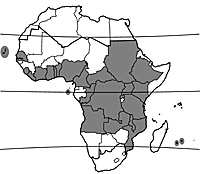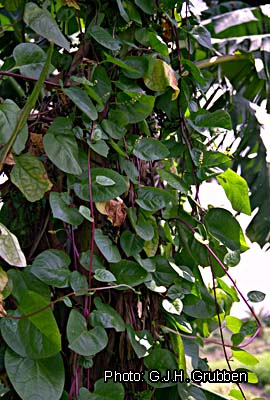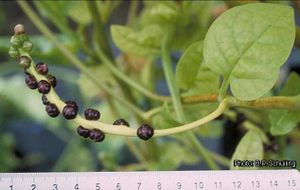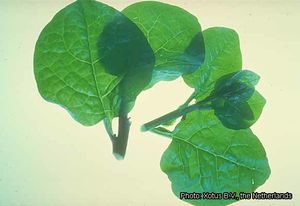Basella alba (PROTA)
Introduction |
| General importance | |
| Geographic coverage Africa | |
| Geographic coverage World | |
| Vegetable | |
| Dye / tannin | |
| Medicinal | |
| Timber | |
| Ornamental | |
| Forage / feed | |
| Food security | |
Basella alba L.
- Protologue: Sp. pl. 1: 272 (1753).
- Family: Basellaceae
- Chromosome number: 2n = 44, 48
Synonyms
- Basella rubra L. (1753),
- Basella lucida L. (1759),
- Basella cordifolia Lam. (1783).
Vernacular names
Ceylon spinach, vine spinach, Gambian spinach, Malabar nightshade, Indian spinach (En).
- Baselle, brède de Malabar, épinard indien, brède d’Angola (Fr).
- Bacela, bertalha (Po).
- Mboga buterezi (Sw).
Origin and geographic distribution
Ceylon spinach is usually considered a native of southern Asia, but its exact origin is not known. It is now widely cultivated and naturalized in the tropics and is even grown in temperate zones as an annual. In tropical Africa, it is most common in warm, humid regions and becomes rare towards the drier or colder parts of the continent. It has been recorded in many countries, but probably occurs throughout tropical Africa.
Uses
Ceylon spinach is commonly grown for its young shoots, which make a succulent, slightly mucilaginous vegetable. It is boiled, used as a potherb in stews or soups, fried in oil, or sometimes used as a green salad. Ceylon spinach is popular among Europeans in Africa as a substitute for spinach, and young tops and seedlings are used as a substitute for corn salad (Valerianella locusta (L.) Laterr.). Its fruits have been used for dyeing; the red fruit juice can be used as ink, as cosmetic and for colouring foods. A number of medicinal applications have been reported: young leaves are used as a laxative, and the red fruit juice as eye-drops to treat conjunctivitis. In Kenya the leaves are used to cure stomachache and constipation after childbirth, pulped leaves are applied as a poultice to sores. In East Africa the plant is given to livestock to increase milk production. Red forms of Basella alba are commonly planted as ornamentals, and are even popular in Europe and North America as potplants.
Production and international trade
Ceylon spinach is sold in many local markets. It is a minor vegetable and since it is generally grouped together with other greens, no data on production or trade are available.
Properties
The composition of fresh Ceylon spinach shoots per 100 g edible portion is: water 93 g, energy 79 kJ (19 kcal), protein 1.8 g, fat 0.3 g, carbohydrate 3.4 g, Ca 109 mg, P 52 mg, Fe 1.2 mg, vitamin A 8000 IU, thiamin 0.05 mg, riboflavin 0.16 mg, niacin 0.50 mg, folate 140 μg, ascorbic acid 102 mg (USDA, 2002). The composition is comparable to other dark green leafy vegetables with a high moisture content.
The leaves contain several triterpene oligoglycosides of the oleanane-type, including basellasaponins, betavulgaroside I, spinacoside C and momordins. Two antifungal peptides and two ribosome-inactivating proteins with antiviral activity have been isolated from the seeds.
Description
- Short-lived perennial herb up to 4(–8) m long, succulent; stem twining, slender, smooth, green or purplish.
- Leaves alternate, simple, fleshy; stipules absent; petiole up to 9 cm long; blade ovate to heart-shaped, 2.5–15 cm × 2–12.5 cm, usually cordate at base, acute or acuminate at apex, dark green or purplish.
- Inflorescence an axillary spike up to 22(–30) cm long, hanging, with long peduncle.
- Flowers bisexual, regular, 5-merous, sessile, 2.5–6 mm long, white, pink or purple; perianth fleshy, urceolate, remaining closed; stamens inserted near apex of perianth tube; ovary superior, 1-celled, ovoid, style with 3 linear stigmas.
- Fruit a subglobose pseudo-berry 4–7(–10) mm in diameter, enveloped by the fleshy perianth, purplish black, containing a violet juice, 1-seeded.
$Seed globose, c. 3 mm in diameter, dark brown to black.
- Seedling with epigeal germination; cotyledons large; first leaves opposite, later ones alternate.
Other botanical information
Basella comprises 5 species, 3 of which are endemic to Madagascar and 1 to eastern Africa. Basella alba can be confused with Anredera cordifolia (Ten.) Steenis, which is sometimes cultivated as an ornamental in tropical Africa. The latter can be distinguished by its slender racemes of pedicellate, non-fleshy flowers.
Growth and development
After germination of the seed, growth of the creeping or climbing stem is fast and lateral branches are soon formed. Ceylon spinach sends out runners over the soil which develop new roots at the nodes, thus growing on indefinitely. Harvesting the young tips stimulates branching. Leaves on lateral branches are smaller than those on runners, and with plant senescence leaf size decreases. Flowering starts about 6 weeks after sowing. The flowers are self-pollinated. The fruits ripen in about 1 month. Basella alba is often cultivated as an annual, but with adequate care it persists for over one year in cultivation.
Ecology
Ceylon spinach does well in tropical lowlands at elevations up to 500 m, but it survives even at 2600 m altitude and in temperate regions. Under natural conditions, it can be found in forest margins and clearings, and in thickets, often in slightly wet localities. Ceylon spinach does not tolerate frost. The optimal temperature range is 20–35°C. It is a short-day plant; flowering is inhibited at daylengths longer than 13 hours. It responds to light shading by producing larger and more succulent leaves than when fully exposed. It is one of the tropical species that has a C4 photosynthetic pathway, resulting in fast photosynthesis and high dry matter production under high light intensity, high temperature and adequate moisture and soil fertility. Ceylon spinach tolerates high rainfall and survives short periods of drought. Water stress encourages early flowering. It grows well in a variety of soils, but prefers humus-rich well-drained soils with pH 5.5–7.0. It does not like stagnant water. It will produce some foliage even on poor shallow soils, but is intolerant of salinity.
Propagation and planting
Ceylon spinach is grown as a short-term crop of 2–4 months without support or as a long-term crop grown on trellises. Propagation is by seed or, occasionally, by cuttings of about 20 cm long. For short-term crops direct sowing is practised, as well as transplanting of seedlings or cuttings. Seedlings 10–15 cm tall or rooted cuttings are transplanted to beds at a square spacing of 40–50 cm × 40–50 cm or in rows 60–70 cm apart and 25–30 cm between plants. Plants grown from seed are more productive than those grown from cuttings. The 1000-seed weight is 30–40 g. For a short-term crop, Ceylon spinach may be direct sown at a rate of 300 seeds per m2 (10 g/m2) in rows 10 cm apart. Thinning is done to 100 plants per m2 after 15 days at the cotyledon stage. For a long-term crop, 3–4 seeds per hole are sown directly into beds, in double lines on either side of supports 1.2–1.5 m high, with 60 cm between the rows and 30 cm in the row. When grown on a commercial scale, a density of 5 plants per m2 is often practised.
Management
Watering should be liberal until plants are well established; subsequently irrigation of about 8 mm daily is required during dry periods. Partial shading is recommended because it results in the production of larger and more succulent leaves. Trellising has the advantage that the foliage is kept off the ground. This facilitates harvesting and keeps the leaves clean. Ceylon spinach can do well under conditions of moderate fertility, but is responsive to supplemental NPK and organic fertilizer. An appropriate rate of fertilization is up to 100 t/ha organic manure supplemented with 250 kg/ha NPK 10–10–20 before planting, followed by 250 kg/ha NPK after 1 month. Straw mulching is beneficial especially in the early stages of development and during dry periods to conserve water.
For seed production, plants are grown on trellises during the dry season with irrigation. Fruits are picked when dry; a seed yield of 1000–2000 kg/ha can be obtained.
Diseases and pests
Ceylon spinach is very susceptible to root-knot nematodes (Meloidogyne spp.). The damage is reduced by the application of a high dose of organic manure. Crop rotation with non-susceptible crops such as maize or amaranth is recommended. Ceylon spinach is remarkably free of foliar diseases and pests due to the thick leaf cuticle. Necrotic leaf spots caused by Cercospora basellae and Acrothecium basellae sometimes occur. Young plants are susceptible to Rhizoctonia rot. A rust (possibly Puccinia species) causing yellow-orange spots on the leaves is reported as problematic in Congo. Removal of all infected leaves is recommended in order to reduce the inoculum rate.
Harvesting
The harvest of a short-term crop begins about 3 weeks after sowing. Tips of branches 15–25 cm long are pinched out weekly for a period of about 2 months. For a long-term crop, the harvest starts 5–6 weeks after sowing, or somewhat earlier if cuttings were used. For transplanted seedlings, harvesting starts 50–70 days after transplanting. Harvesting continues at regular intervals for up to 6 months, when the leaves become too small.
Yield
A short-term crop yields up to 40 t/ha in 75 days; for long-term crops, yields are very variable, up to 1.5 kg of shoots or leaves per plant or 80 t/ha in 180 days. Yields of 20–50 t/ha per month of cultivation have been reported.
Handling after harvest
To reduce deterioration the shoots are tied in bunches. Ceylon spinach keeps only one day at temperatures of 20–30°C. For longer storage, the product should be kept in a cool room. The leaves are not usually dried.
Genetic resources
Basella alba is not endangered because local selections are commonly grown in home gardens and for the market. It has been included in the traditional African Vegetables Mandate list for conservation in the SADCC region. No germplasm collection by national genebanks is reported. Germplasm is being conserved in situ in the custody of the farmers. Collection and screening of local material is advisable.
Breeding
No breeding programmes are known to exist, although several seed companies in India and the United States offer their own selections.
Prospects
Ceylon spinach has good prospects as a productive leafy vegetable with excellent nutritional properties, a remarkable resistance to diseases and pests, suitable for backyard cultivation as well as for market gardens in the lowland tropics.
Major references
- FAO, 1988. Traditional food plants: a resource book for promoting the exploitation and consumption of food plants in arid, semi-arid and sub-humid lands of Eastern Africa. FAO food and nutrition paper 42. FAO, Rome, Italy. 593 pp.
- Grubben, G.J.H., 1977. Tropical vegetables and their genetic resources. IBPGR, Rome, Italy. 197 pp.
- Guarino, L. (Editor), 1997. Traditional African vegetables. Proceedings of the IPGRI international workshop on genetic resources of traditional vegetables in Africa: conservation and use, 29–31 August 1995, ICRAF, Nairobi, Kenya. Promoting the conservation and use of underutilized and neglected crops 16. IPGRI, Rome, Italy. 171 pp.
- Messiaen, C.-M., 1989. Le potager tropical. 2nd Edition. Presses Universitaires de France, Paris, France. 580 pp.
- Rahmansyah, M., 1993. Basella alba L. In: Siemonsma, J.S. & Kasem Piluek (Editors). Plant Resources of South-East Asia No 8. Vegetables. Pudoc Scientific Publishers, Wageningen, Netherlands. pp. 93–95.
- Sidwell, K., 1999. Typification of two Linnaean names in the Basellaceae. Novon 9(4): 562–563.
- Tindall, H.D., 1983. Vegetables in the tropics. Macmillan Press, London, United Kingdom. 533 pp.
- USDA, 2002. USDA nutrient database for standard reference, release 15. [Internet] U.S. Department of Agriculture, Beltsville Human Nutrition Research Center, Beltsville Md, United States. http://www.nal.usda.gov/fnic/foodcomp. June 2003.
Other references
- Makambila, C., 1986. Une nouvelle maladie de la baselle (Basella sp.) au Congo. L’Agronomie Tropicale 41(1): 69–73.
- Maundu, P.M., Ngugi, G.W. & Kabuye, C.H.S., 1999. Traditional food plants of Kenya. Kenya Resource Centre for Indigenous Knowledge (KENRIK), Nairobi, Kenya. 270 pp.
- Murakami, T., Hirano, K. & Yoshikawa, M., 2001. Medicinal foodstuffs. 23. Structures of new oleanane-type triterpene oligoglycosides, basellasaponins A, B, C, and D, from the fresh aerial parts of Basella rubra. Chemical and Pharmaceutical Bulletin 49(6): 776–770.
- Olembo, N.K., Fedha, S.S. & Ngaira, E.S., 1995. Medicinal and agricultural plants of Ikolomani Division, Kakamega district, Kenya. Development Partners, Kakamega, Kenya. 107 pp.
- van der Zon, A.P.M. & Grubben, G.J.H., 1976. Les légumes-feuilles spontanés et cultivés du Sud-Dahomey. Communication 65. Département des Recherches Agronomiques, Koninklijk Instituut voor de Tropen, Amsterdam, Netherlands. 111 pp.
- Wang, H. & Ng, T.B., 2001. Novel antifungal peptides from Ceylon spinach seeds. Biochemical and Biophysical Research Communications 288(4): 765–770.
Sources of illustration
- Rahmansyah, M., 1993. Basella alba L. In: Siemonsma, J.S. & Kasem Piluek (Editors). Plant Resources of South-East Asia No 8. Vegetables. Pudoc Scientific Publishers, Wageningen, Netherlands. pp. 93–95.
Author(s)
- M.O. Abukutsa-Onyango, Department of Horticulture, Maseno University, P.O. Private Bag, Maseno, Kenya
Correct citation of this article
Abukutsa-Onyango, M.O., 2004. Basella alba L. [Internet] Record from PROTA4U. Grubben, G.J.H. & Denton, O.A. (Editors). PROTA (Plant Resources of Tropical Africa / Ressources végétales de l’Afrique tropicale), Wageningen, Netherlands.
Accessed 6 March 2025.






